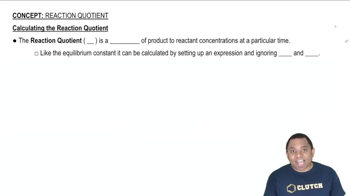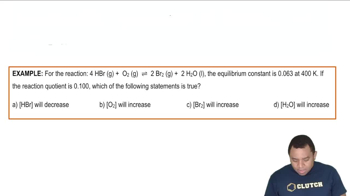A mixture of 0.2000 mol of CO2, 0.1000 mol of H2, and 0.1600 mol of H2O is placed in a 2.000-L vessel. The following equilibrium is established at 500 K: CO2(g) + H2(g) ⇌ CO(g) + H2O(g) (d) Calculate Kc for the reaction.
Ch.15 - Chemical Equilibrium
Chapter 15, Problem 41a
Indicate whether each of the following statements about the reaction quotient Q is true or false: (a) The expression for 𝑄𝑐 looks the same as the expression for 𝐾𝑐.
 Verified step by step guidance
Verified step by step guidance1
Understand that both the reaction quotient \( Q_c \) and the equilibrium constant \( K_c \) are calculated using the same expression, which is the ratio of the concentrations of the products to the reactants, each raised to the power of their stoichiometric coefficients.
Recognize that the difference between \( Q_c \) and \( K_c \) lies in the state of the reaction: \( Q_c \) is calculated at any point in time, while \( K_c \) is specifically at equilibrium.
Write the general expression for \( Q_c \) for a reaction: \( aA + bB \rightleftharpoons cC + dD \), where \( Q_c = \frac{[C]^c[D]^d}{[A]^a[B]^b} \).
Note that the expression for \( K_c \) is identical to that of \( Q_c \), \( K_c = \frac{[C]^c[D]^d}{[A]^a[B]^b} \), but it is evaluated when the system is at equilibrium.
Conclude that the statement is true because the mathematical expressions for \( Q_c \) and \( K_c \) are indeed the same, differing only in the conditions under which they are evaluated.

Verified video answer for a similar problem:
This video solution was recommended by our tutors as helpful for the problem above.
Video duration:
1mWas this helpful?
Key Concepts
Here are the essential concepts you must grasp in order to answer the question correctly.
Reaction Quotient (Q)
The reaction quotient, denoted as Q, is a measure of the relative concentrations of products and reactants in a chemical reaction at any point in time. It is calculated using the same expression as the equilibrium constant (K), but it can be evaluated at any set of concentrations, not just at equilibrium. Q helps determine the direction in which a reaction will proceed to reach equilibrium.
Recommended video:
Guided course

Reaction Quotient Q
Equilibrium Constant (K)
The equilibrium constant, represented as K, quantifies the ratio of the concentrations of products to reactants at equilibrium for a reversible reaction. It is a specific value that remains constant at a given temperature and is derived from the balanced chemical equation. K provides insight into the extent of a reaction and whether products or reactants are favored at equilibrium.
Recommended video:
Guided course

Equilibrium Constant K
Comparison of Q and K
The relationship between Q and K is crucial for predicting the behavior of a reaction. If Q < K, the reaction will proceed in the forward direction to produce more products; if Q > K, the reaction will shift backward to form more reactants. When Q equals K, the system is at equilibrium, and no net change occurs. Understanding this comparison is essential for analyzing dynamic chemical systems.
Recommended video:
Guided course

Comparing Q to K Example
Related Practice
Textbook Question
1
views
Textbook Question
Indicate whether each of the following statements about the reaction quotient Q is true or false: (b) If 𝑄𝑐 < 𝐾𝑐, the reaction needs to proceed to the right to reach equilibrium.
Textbook Question
At 100°C, the equilibrium constant for the reaction COCl2(𝑔) ⇌ CO(𝑔) + Cl2(𝑔) has the value 𝐾𝑐 = 2.19×10−10. Are the following mixtures of COCl2, CO, and Cl2 at 100°C at equilibrium? If not, indicate the direction that the reaction must proceed to achieve equilibrium.
(a) [COCl2] = 2.00×10−3 M, [CO] = 3.3×10−6 M, [Cl2] = 6.62×10−6 M
(b) [COCl2] = 4.50×10−2 M, [CO] = 1.1×10−7 M, [Cl2] = 2.25×10−6 M
(c) [COCl2] = 0.0100 M, [CO] = [Cl2] = 1.48×10−6 M
